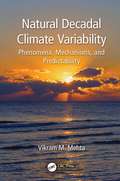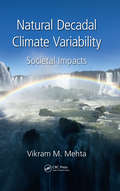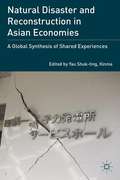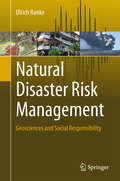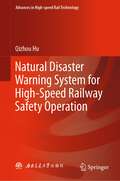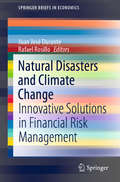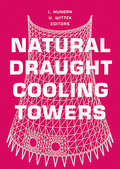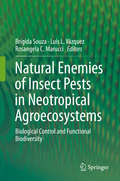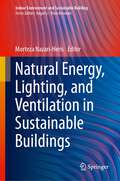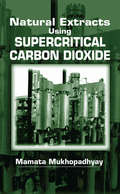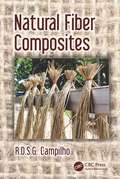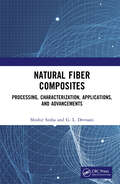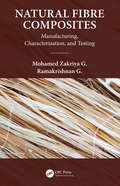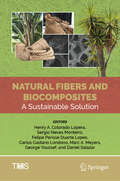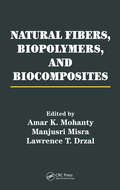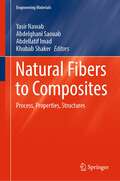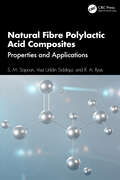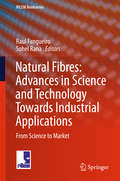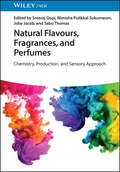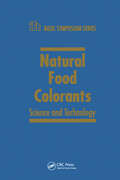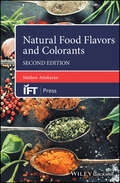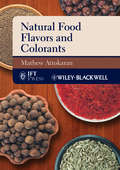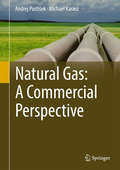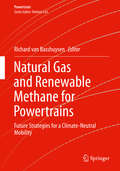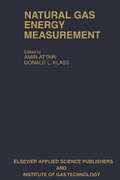- Table View
- List View
Natural Decadal Climate Variability: Phenomena, Mechanisms, and Predictability
by Vikram M. MehtaNatural decadal climate variability (DCV) and its interactions with anthropogenic climate change (ACC) are vitally important to understand to predict the future of the Earth’s climate. This book, after familiarizing readers with the importance of understanding and predicting DCV phenomena and its distinction from ACC phenomena, comprehensively explains the physics of DCV, integrating paleoclimate proxy and modern instrument-based data and simulations with climate models. Features of this book: Uniquely focuses on natural DCV, its physics, and its predictability Presents an integrated view of DCV phenomena based on approximately 700 peer-reviewed publications cited in the book Includes research on influences of decadal variability in solar emissions on the Earth’s climate, with a historical perspective going back several centuries Describes progress in decadal climate predictability and prediction research, with a historical perspective on weather and climate predictability research This book is an excellent resource for graduate students, faculty members and other teachers and researchers, and anyone who is interested in learning about a very important component of the puzzle of the changing climate. "This book provides a comprehensive review…. Highlighted throughout the book are potential links between DCV and solar variability, a fascinating topic that has engaged our minds for centuries. Written by an expert with more than 30 years’ experience, this book should be an invaluable resource for students and researchers interested in how our climate will evolve over the coming decades." Doug Smith, Decadal Climate Prediction Leader, Meteorological Office Hadley Centre, UK "This book is a tour de force by the author who has spent his career studying decadal climate variability. He brings new insights to the vast scope of this topic, providing clearly understandable descriptions of the various aspects." Gerald Meehl, Senior Scientist, National Center for Atmospheric Research, Colorado, USA
Natural Decadal Climate Variability: Societal Impacts (Drought and Water Crises)
by Vikram M. MehtaNatural Decadal Climate Variability: Societal Impacts is an important work for understanding the natural decadal climate variability (DCV), a phenomenon which has made long lasting impacts on civilizations, especially on water availability and agriculture. This book comprehensively covers multiyear to decadal variations in instrument measured precipitation and temperature, water availability and river flows, crop production, agricultural irrigation, inland water-borne transportation, hydroelectricity generation, and fish and crustacean captures since the 1960s. A longer term perspective is provided with the use of multi-century data on dry and wet epochs based on tree ring information, and corroborating evidence from other literature. This valuable work will benefit climate scientists, meteorologists, hydrologists, agronomists, water transportation planners, resource economists, policymakers, professors, and graduate students and anyone else who has an interest in learning how natural climate phenomena has influenced societies for at least the past 1000 years.
Natural Disaster and Reconstruction in Asian Economies
by Yau Shuk-Ting KinniaBased on conference proceedings presented at The Chinese University of Hong Kong in November 2012, Natural Disaster and Reconstruction in Asian Economies offers leading insight into and viewpoints on disasters from scholars and journalists working in Japan, China, the United States, and Southeast Asia.
Natural Disaster Risk Management
by Ulrich RankeThis textbook provides a thorough introduction to natural disaster risk management. Many aspects of disaster risk management, such as those involved in earthquakes, volcanic eruptions, floods, avalanches and mudslides call for similar prevention and preparedness instruments, management concepts, and countermeasures. This textbook assumes the viewpoint of a regional disaster risk manager who is responsible for a certain area, and for making the lives of the people who live there safer, regardless of the type of natural disaster that may occur. The same holds true for boosting preparedness and awareness in the population at risk. The book includes numerous examples of hazard mitigation concepts and techniques, as well as ways of intensively involving the local population in prevention schemes at an early stage. Furthermore, it provides an in-depth examination of the function of risk communication, both as an instrument for disseminating official information and as a function of public media. In closing, a chapter on risk splitting offers insights into insurance-based models for risk financing. This comprehensive book is a must-read for all students, researchers and practitioners dealing with natural disaster risk management.
Natural Disaster Warning System for High-Speed Railway Safety Operation (Advances in High-speed Rail Technology)
by Qizhou HuThis book explores the mechanisms behind high-speed railway (HSR) traffic accidents caused by natural disasters, employing the concept of “dynamic tracking, situation assessment, and early warning management”. It establishes a natural disaster warning system for ensuring the safety of HSR operations, while providing insightful management measures and methods that address the challenges posed by natural disasters. By analyzing the current state and objective circumstances of HSR safety operations, this book distinguishes itself from similar publications both domestically and internationally. It conducts an in-depth analysis of the safe operation of high-speed railways by adopting a systems science approach that effectively merges theory with practical applications. Furthermore, the book explores the developmental trajectory of high-speed railways and investigates the determination of their safe operation. It comprehensively evaluates the safety of high-speed railway operations by employing mathematical theories of uncertainty, subsequently presenting detailed measures to effectively tackle safety concerns related to high-speed railways.
Natural Disasters and Climate Change: Innovative Solutions in Financial Risk Management (SpringerBriefs in Economics)
by Juan José Durante Rafael RosilloThis book presents a technical approach to promoting the development of disaster and climate change risk financing and transfer strategies, and discusses several practical issues, chiefly focusing on Latin America and the Caribbean. Innovative risk financing and insurance mechanisms are vital for governments around the world, in order to provide financial protection and reduce the economic costs and social and developmental impacts of natural disasters and climate change. The book’s main content is complemented by a wealth of graphics, diagrams and tables that illustrate the concepts discussed and make the text accessible for practitioners and non-practitioners alike. The book offers proven, creative and innovative ideas on how to tackle risk financing and management for natural disasters and climate change. Strategic topics such as sovereign disaster risk financing, property catastrophe risk insurance, and agricultural insurance are also discussed.
Natural Draught Cooling Towers: Proceedings of the Fifth International Symposium on Natural Draught Cooling Towers, Istanbul, Turkey, 20-22 May 2004
by I. Mungan U. WittekThe world's most experienced scientists and professionals working on cooling towers gathered at the 5th International Symposium on Natural Draught Cooling Towers to discuss the latest developments in this area and exchange knowledge and experiences. This book comprises 43 contributions on the latest developments in the field of natural draught cool
Natural Enemies of Insect Pests in Neotropical Agroecosystems: Biological Control and Functional Biodiversity
by Brígida Souza Luis L. Vázquez Rosangela C. MarucciThis book aims to address the importance of natural enemies and functional diversity for biological control in Neotropical agroecosystems. Several aspects related to the conservation of natural enemies, such as vegetation design and climate change, are discussed in Part 1 and the bioecology of several insects groups used in biological control in Latin America is presented in Part 2. Part 3 is devoted to mass production of natural enemies while Part 4 describes how these insects have been used to control of pests in major crops, forests, pasture, weeds and plant diseases. Lastly, Part 5 reports Latin-American experiences of integration of biological in pest management programs.
Natural Energy, Lighting, and Ventilation in Sustainable Buildings (Indoor Environment and Sustainable Building)
by Morteza Nazari-HerisThis book explores the theoretical background and provides an experimental analysis of using natural energy resources in sustainable building design. It brings together an international group of contributors focusing on ways natural energy, lighting, and ventilation can improve the performance of electrical, lighting, and mechanical systems. Contributions explore how natural resources can contribute to sustainable development goals while meeting energy demands and maintaining acceptable interior air quality and natural illumination needs. Coverage includes green building design, renewable energy integration, photovoltaic systems, small-scale wind turbines, natural lighting, and natural ventilation. Natural Energy, Lighting, and Ventilation in Sustainable Buildings offers practical and promising solutions for novel challenges in sustainable design for electrical engineers, energy engineers, architectural engineers, and related professionals, as well as researchers and developers from engineering science.
Natural Extracts Using Supercritical Carbon Dioxide
by Mamata MukhopadhyaySynthesizing research from a wide variety of sources, this work offers a convenient guide to a clean, safe, inexpensive, non-toxic, non-polluting solvent that performs better than most conventional solvents. Natural Extracts Using Supercritical Carbon Dioxide reviews recent development in the technology and its applications to the food, flavor, fra
Natural Fiber Composites (Composite Materials)
by R.D.S.G. CampilhoThis book brings value to anyone working with or designing natural fiber composite structures. It helps readers understand the value these materials can add to projects, how to choose the best materials and treatments, how to safely design and fabricate products made of natural fiber composites, and how to test them for safety. It covers the characterization of natural fibers, matrices and respective composites, and how to enhance their performance and processing as well as testing and degradation issues.
Natural Fiber Composites: Processing, Characterization, Applications, and Advancements
by Shishir Sinha G.L DevnaniThis book focuses on the key areas and issues related to natural fibers and their reinforced polymer composites. It begins with an introduction and classification of natural fibers and their different extraction methods, followed by characterization techniques. Further, this book gives solutions to improved adhesion between natural fibers and different polymer matrices via different chemical, physical, and biological treatment methods. Fabrication procedures and characterization techniques for development and testing of composites, including processing, development, and characterization, have been included as well. Applications of these composite materials for food packaging and structural and semi-structural applications are also explained. FEATURES Describes the extraction process of natural fibers with comparisons Covers the fundamental concepts for the characterization of natural fiber composites Includes a comparative study of different polymer matrices Provides insight about various fabrication methods Discusses diverse applications of these novel materials and the scope for commercialization and entrepreneurship This book is aimed at graduate students and researchers in materials, polymers, composites and characterization, textile engineering, chemical, civil, and mechanical engineering.
Natural Fiber Composites: Manufacturing, Characterization and Testing
by Mohamed Zakriya G Ramakrishnan GovindanThis book covers the use of accessible natural fibers towards the requirement and compatibility of industrial sustainability. Using natural characteristics of composites through technology and techniques, the inherent qualities of natural fibers are discussed in relation to the design of experiments. This book also elaborates on the durability of composites subjected to environmental conditions, biodegradability, environmental issues, product life cycle assessment and testing methods. Offers detailed coverage of functional aspects of natural fiber composites along with applications Discusses natural fiber inherent character based composite formation techniques Reviews micro-mechanical and macro-mechanical properties and functional use of natural fiber reinforced composites Content based on functional requirements selection and process consideration Discusses product life cycle assessment and recycling techniques This book is aimed at researchers, students, industrialists, and fabricators of composites.
Natural Fibers and Biocomposites: A Sustainable Solution (The Minerals, Metals & Materials Series)
by Henry A. Colorado Lopera Sergio Neves Monteiro Felipe Perisse Duarte Lopes Carlos Castano Londono Marc A. Meyers George Youssef Daniel SalazarNatural fibers' abundance, excellent properties, biodegradability, and low cost make this renewable resource a green alternative to synthetic fibers for composite material reinforcement. The need to create sustainable solutions has promoted applications in sports, transportation, armor, medicine, infrastructure, construction and building materials, and architecture. This collection promotes the use of natural materials and their composites as a possible strategy to increase environmental sustainability, as well as to study materials fundamentals for new applications. Topics include but are not limited to: • Properties and fundamentals of natural fibers • Surface modifications to improve properties • Biocomposite materials and potential contributions to sustainability • Durability, dynamic behavior, adhesion, impact response, mechanical, thermal, and other properties related to natural materials and their composites
Natural Fibers, Biopolymers, and Biocomposites
by Amar K. Mohanty Manjusri Misra Lawrence T. DrzalNatural/Biofiber composites are emerging as a viable alternative to glass fiber composites, particularly in automotive, packaging, building, and consumer product industries, and becoming one of the fastest growing additives for thermoplastics. Natural Fibers, Biopolymers, and Biocomposites provides a clear understanding of the present state
Natural Fibers to Composites: Process, Properties, Structures (Engineering Materials)
by Yasir Nawab Abdelghani Saouab Abdellatif Imad Khubab ShakerNatural fiber composites are a preferred alternative to conventional composites due to their environment-friendly nature. However, their market share is limited due to: a) limited number and quantities of natural fibers available for composites, b) diversity in fibers structure, c) poor mechanical properties of fibers as well as composites, d) susceptibility to microbial attacks, and e) cellulose degradation temperature around 200 deg C, which hinders the development of natural fiber reinforced thermoplastic composites using thermoforming at high temperatures. A number of researchers have contributed to the solution of the problem of poor mechanical properties and issues related to fabrication during the last decade. This book covers these different solutions. The book is divided into two principal themes: a) structure–property relationship: fibers to composites—it includes the discussion on fibers, their surface modifications, variation in the structure of reinforcement, and approaches for the enhancement of properties. b) Fabrication process of composites—it includes the novel approaches used for the development of natural fiber composites using the commingling technique for thermoplastic composites.
Natural Fibre Polylactic Acid Composites: Properties and Applications
by S. M. Sapuan Vasi Uddin Siddiqui R. A. IlyasThis text provides readers with a comprehensive understanding of the properties, processing techniques, and applications of natural fibre-reinforced PLA composites, enabling them to develop sustainable and high-performance materials for a range of industries. It encompasses a wide range of topics within the field, spanning fundamentals, manufacturing processes and techniques, and applications. Covers types, characteristics, and sources of natural fibres. Delves into the unique properties of PLA as a matrix material and examines natural fibre-reinforced PLA biocomposites, hybrid biocomposites, and nanofiber-reinforced bionanocomposites. Explores various processes and techniques for fabricating natural fibre composites, emphasizing the influence of fibre-matrix interactions and surface modifications on the resulting properties. Discusses techniques for manufacturing components from these composites, including injection molding, extrusion, and 3D printing. Offers lifecycle assessments of natural-fibre reinforced PLA composites, evaluating their environmental impact and sustainability. Showcases a broad range of applications in industries such as automotive, construction, packaging, aviation, and consumer goods. With its comprehensive coverage, scientific approach, and technical depth, this book serves as an invaluable resource for researchers, engineers, and practitioners seeking to advance their knowledge and expertise in the field of natural fibre-reinforced PLA composite materials.
Natural Fibres: Advances in Science and Technology Towards Industrial Applications
by Raul Fangueiro Sohel RanaThis book collects selected high quality articles submitted to the 2nd International Conference on Natural Fibers (ICNF2015). A wide range of topics is covered related to various aspects of natural fibres such as agriculture, extraction and processing, surface modification and functionalization, advanced structures, nano fibres, composites and nanocomposites, design and product development, applications, market potential, and environmental impact. Divided into separate sections on these various topics, the book presents the latest high quality research work addressing different approaches and techniques to improve processing, performance, functionalities and cost-effectiveness of natural fibre and natural based products, in order to promote their applications in various advanced technical sectors. This book is a useful source of information for materials scientists, teachers and students from various disciplines as well as for R& D staff in industries using natural fibre based materials.
Natural Flavours, Fragrances, and Perfumes: Chemistry, Production, and Sensory Approach
by Sabu Thomas Sreeraj Gopi Nimisha Pulikkal Sukumaran Joby JacobNatural Flavours, Fragrances, and Perfumes Explore this one-stop resource on every relevant aspect of natural flavors and fragrances The use of sensory science has the potential to give scientists, researchers, and industry specialists a way to overcome the challenges in nutraceuticals and, more generally, in the functional food industry. Flavor and fragrance have the potential to significantly influence consumer satisfaction with products and its success in the marketplace. In order to effectively produce and optimize a customer’s experience in both food and household products, it is essential to have a strong understanding of the fundamentals of chemistry and physicochemical processes. Natural Flavours, Fragrances and Perfumes offers a comprehensive look at the sensory sciences necessary to produce the most appealing olfactory responses derived from natural resources for consumers – from the analysis and biomolecular aspects of natural products to the processing and isolation of desired products, from the perceptual properties to regulatory aspects. Specifically, the book presents novel approaches to the processes involved in producing plant-derived functional products by examining how characteristic flavors arise due to complex interactions between hundreds of molecules, as well as studying the physiological variables that affect flavor perception. Natural Flavours, Fragrances, and Perfumes readers will also find: Insights into the identification and characterization of plant volatiles, as well as chromatography techniques for sensory fingerprints Chapters devoted to biosynthesis and metabolic pathways for the development of household products composed of organic materials Additional chapters on the advances in flavor science, on technological advances in the effective delivery of flavor, and challenges in the retention and release of flavor Natural Flavours, Fragrances, and Perfumes is a useful reference for chemists of all kinds, food scientists, biotechnologists, and perfumers, as well as those studying in these fields.
Natural Food Colorants: Science and Technology
by Gabriel J. Lauro Jack FrancisThis work focuses on the preparation, structure, chemistry, functional properties, stability, handling and applications of naturally-derived colorants approved for use in food products in the USA, Europe and Asia. It presents studies that investigate whether natural colorants reduce risk of heart disease, specific types of cancer, and other conditi
Natural Food Flavors and Colorants
by Mathew AttokaranAlthough many foods are appealing, and even perceived as natural, in spite of containing synthetic additives, consumer increasingly prefer food products which are fully natural. This has driven an increase in the use of, and interest in, food additives derived from biological sources. Of particular interest are natural food flavors and colors, which have started to play a major role in food processing.This volume presents practical information on over 80 natural extracts that can be used as food flavors and colors, drawing on the author's 50 years of food chemistry and technology expertise in both research and industry. The book is divided into three parts: Part I deals with manufacture, quality, analysis, and regulatory aspects. Part II describes the various sources of natural flavors and colorants that are currently available, alphabetized for convenient reference. Part III covers future directions that can be pursued by research workers and manufacturers.Food scientists, researchers and product development professionals alike will find Natural Food Flavors and Colorants an invaluable resource for understanding and using these commercially important natural food ingredients.
Natural Food Flavors and Colorants (Institute of Food Technologists Series)
by Mathew AttokaranAlthough many foods are appealing, and even perceived as natural, in spite of containing synthetic additives, consumer increasingly prefer food products which are fully natural. This has driven an increase in the use of, and interest in, food additives derived from biological sources. Of particular interest are natural food flavors and colors, which have started to play a major role in food processing. This volume presents practical information on over 80 natural extracts that can be used as food flavors and colors, drawing on the author's 50 years of food chemistry and technology expertise in both research and industry. The book is divided into three parts: Part I deals with manufacture, quality, analysis, and regulatory aspects. Part II describes the various sources of natural flavors and colorants that are currently available, alphabetized for convenient reference. Part III covers future directions that can be pursued by research workers and manufacturers. Food scientists, researchers and product development professionals alike will find Natural Food Flavors and Colorants an invaluable resource for understanding and using these commercially important natural food ingredients.
Natural Gas: A Commercial Perspective
by Michael Karasz Andrej PustišekThis book discusses and explains the economics of each stage of the natural gas value chain, including the economic impact of restrictions, rules and decisions that are ostensibly technical in nature, as well as commercially relevant contractual stipulations. Each chapter features several real-world examples illustrating the essential points. Natural gas is broadly considered the (leading) conventional source of primary energy. Complementing renewable energies' utilization and offering a highly flexible yet relatively clean fuel, the worldwide natural gas markets are expected to grow. Despite the fact that Europe - where a degree of stagnation in natural gas consumption is being observed and is expected to continue - is not following this trend, international natural gas markets are becoming increasingly interdependent. Therefore, any analysis and discussion of natural gas markets at each level has to have an international rather than national focus.
Natural Gas and Renewable Methane for Powertrains
by Richard Van BasshuysenThis book focuses on natural gas and synthetic methane as contemporary and future energy sources. Following a historical overview, physical and chemical properties, occurrence, extraction, transportation and storage of natural gas are discussed. Sustainable production of natural gas and methane as well as production and storage of synthetic methane are scrutinized next. A substantial part of the book addresses construction of vehicles for natural and synthetic methane as well as large engines for industrial and maritime use. The last chapters present some perspectives on further uses of renewable liquid fuels as well as natural gas for industrial engines and gas power plants.
Natural Gas Energy Measurement
by Amir Attari Donald L. KlassPapers presented at the First and Second IGT Symposium, Chicago, IL, USA, 26-28 August 1985 and 30 April-2 May 1986.
